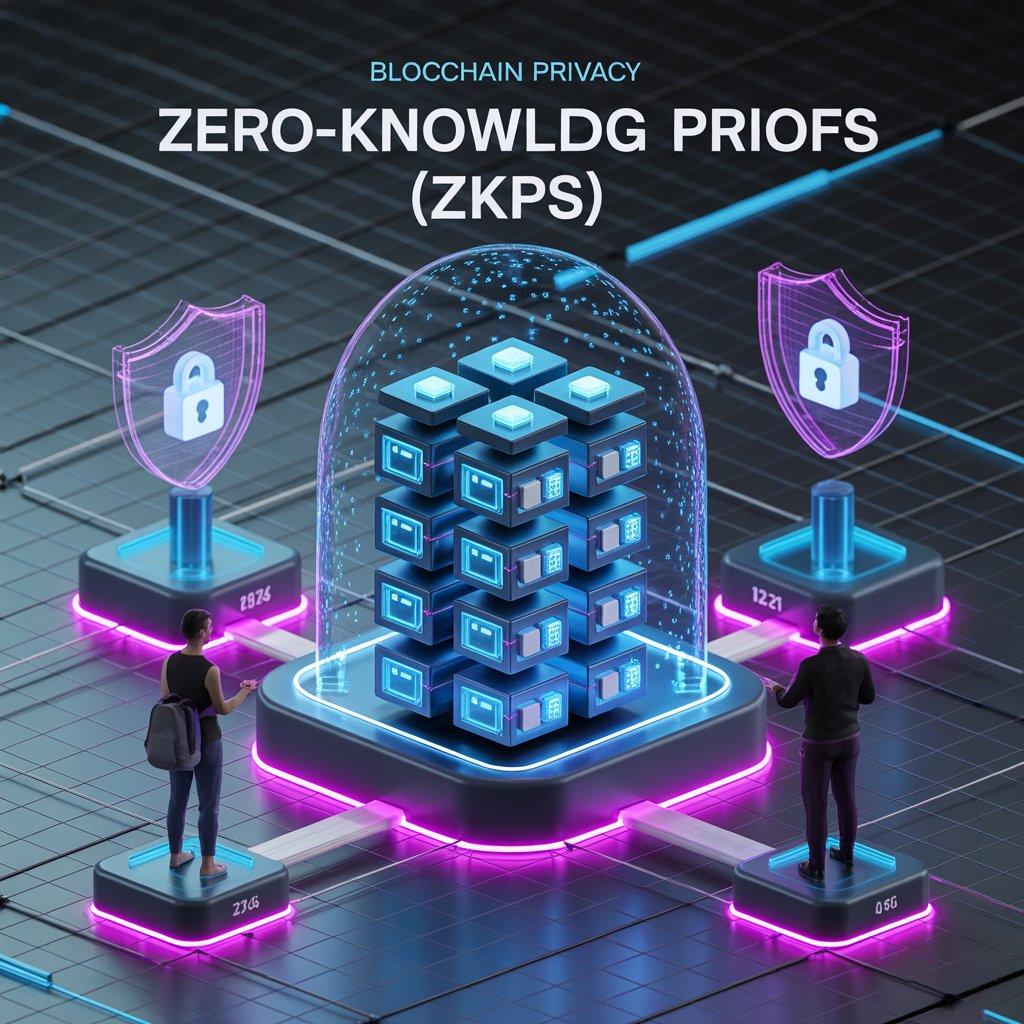The Role of Zero-Knowledge Proofs (ZKPs) in Next-Gen Blockchain Privacy

Introduction
In the rapidly evolving world of blockchain, privacy has become one of the most critical concerns. While transparency is one of blockchain’s greatest strengths, it can also expose user data to unwanted scrutiny. This is where Zero-Knowledge Proofs (ZKPs) enter the picture.
ZKPs allow one party to prove to another that a statement is true without revealing any underlying information. This technology has become a foundational pillar of next-generation blockchain privacy, enhancing security and scalability across decentralized systems.
In this comprehensive guide, we’ll explore how ZKPs work, their role in blockchain privacy, the types of ZKPs, use cases, and how they are shaping the future of Web3.
What Are Zero-Knowledge Proofs (ZKPs)?
Definition
A Zero-Knowledge Proof is a cryptographic technique that enables a “prover” to demonstrate to a “verifier” that they know a piece of information without revealing the actual information.
In simpler terms, it’s like proving you know a password without actually showing the password.
How It Works
ZKPs rely on three core properties:
-
Completeness: If the statement is true, the verifier will be convinced by the prover.
-
Soundness: If the statement is false, no dishonest prover can convince the verifier.
-
Zero-Knowledge: The verifier learns nothing about the secret itself.
For example, imagine proving you’re over 18 to enter a website without disclosing your actual age or ID. That’s the essence of a ZKP.
The Growing Importance of Privacy in Blockchain
Blockchain was initially built for transparency, but as adoption expanded into finance, healthcare, and enterprise systems, the need for confidentiality became critical.
Without privacy layers, blockchain exposes:
-
Transaction details
-
Wallet addresses
-
User identities
-
Smart contract data
Zero-Knowledge Proofs solve this by ensuring that transactions can be verified as valid without revealing their contents. This balance between transparency and privacy is key to next-gen blockchain innovation.
Types of Zero-Knowledge Proofs
There are two main categories of ZKPs — Interactive and Non-Interactive.
| Type | Description | Common Use |
|---|---|---|
| Interactive ZKP (IZKP) | Requires continuous communication between prover and verifier. | Academic models and research protocols. |
| Non-Interactive ZKP (NIZKP) | Uses cryptographic algorithms to eliminate back-and-forth communication. | Blockchain, privacy protocols, and ZK-rollups. |
1. zk-SNARKs
Zero-Knowledge Succinct Non-Interactive Argument of Knowledge (zk-SNARKs) are the most popular form of ZKPs used in blockchain.
They are fast, lightweight, and don’t require continuous interaction, making them ideal for decentralized environments.
Advantages:
-
Compact proof size
-
Fast verification
-
Suitable for mobile and web-based apps
Limitations:
-
Complex setup process (requires trusted setup)
-
Susceptible to setup compromise
2. zk-STARKs
Zero-Knowledge Scalable Transparent ARguments of Knowledge (zk-STARKs) are a newer and improved version of zk-SNARKs.
They remove the need for a trusted setup and use transparent cryptographic hashes.
Advantages:
-
No trusted setup
-
Quantum-resistant
-
Higher scalability
Limitations:
-
Larger proof size
-
More computationally intensive
3. Bulletproofs
Bulletproofs are another type of ZKP used primarily in confidential transactions on privacy-focused blockchains like Monero.
Advantages:
-
Smaller proof sizes
-
No trusted setup
-
Efficient for confidential transactions
Limitations:
-
Slower verification time compared to zk-SNARKs
How Zero-Knowledge Proofs Enhance Blockchain Privacy
ZKPs allow for verifiable computation without exposing private data. Here’s how they improve blockchain systems:
1. Transaction Privacy
ZKPs make it possible to validate transactions without revealing sender, receiver, or amount details.
Projects like Zcash and Aztec Network use this approach to protect user confidentiality while keeping transactions verifiable.
2. Identity Protection
In decentralized identity (DID) systems, ZKPs enable self-sovereign identity — users can prove who they are without revealing unnecessary personal information.
Example:
-
A user can prove they are a verified employee without revealing their employee ID number.
3. Smart Contract Confidentiality
Developers can build private smart contracts that execute logic on encrypted data.
This is critical in industries like finance or healthcare where confidentiality is mandatory.
4. Cross-Chain and Layer-2 Scalability
ZK-rollups (like zkSync and StarkNet) leverage ZKPs to bundle multiple transactions into one, reducing blockchain load while maintaining security.
This not only ensures privacy but also drastically improves throughput and scalability.
ZKPs in Action: Real-World Use Cases
1. Zcash
One of the first blockchains to use zk-SNARKs for shielded transactions.
Users can choose between transparent and private modes, depending on their privacy needs.
2. Polygon zkEVM
Polygon’s zkEVM uses ZK-rollups to bring privacy and scalability to Ethereum-compatible smart contracts, enabling faster and cheaper transactions.
3. Aztec Network
A privacy-focused Layer-2 solution for Ethereum using zk-SNARKs to encrypt transaction details while maintaining verifiability.
4. Mina Protocol
Mina uses zk-SNARKs to keep the blockchain lightweight (22KB) regardless of transaction volume — enabling mobile-friendly decentralization.
5. Aleo
Aleo leverages ZKPs for private decentralized applications (dApps), letting developers build on-chain programs without revealing sensitive user data.
Benefits of ZKPs for Next-Gen Blockchain Privacy
| Benefit | Description |
|---|---|
| Enhanced Data Privacy | Users can transact and interact securely without exposing personal or transaction data. |
| Improved Scalability | ZK-rollups bundle multiple transactions into one, reducing network congestion. |
| Regulatory Compliance | ZKPs enable selective disclosure — proving compliance without exposing sensitive data. |
| Security Against Quantum Threats | zk-STARKs and newer ZKP models offer quantum-resistant encryption. |
| User Trust and Adoption | Privacy builds confidence, encouraging broader blockchain adoption across enterprises. |
Challenges and Limitations of ZKPs
Despite their potential, ZKPs are still evolving and face several challenges:
1. Computational Complexity
ZKPs require heavy cryptographic computations, making them resource-intensive and difficult for smaller devices.
2. Trusted Setup (for zk-SNARKs)
If the trusted setup is compromised, the entire system’s security can be at risk.
3. Lack of Standardization
Different projects use different ZKP implementations, which complicates interoperability.
4. Developer Barriers
Building ZKP-based systems requires advanced cryptographic knowledge — a significant barrier for new developers.
5. Verification Costs
While ZKPs reduce transaction size, the computational verification process can still be expensive on-chain.
The Future of ZKPs in Blockchain
The evolution of Zero-Knowledge Proofs represents a turning point for blockchain privacy.
As technology matures, expect to see:
-
ZK-rollups are becoming standard on Layer-2 solutions.
-
Cross-chain privacy protocols enabling secure data transfer.
-
ZKP-as-a-Service platforms for enterprises seeking confidential data solutions.
-
Integration in Web3 Identity and Metaverse for privacy-preserving user authentication.
According to industry research, the ZKP market size is projected to exceed $5 billion by 2030, driven by demand for decentralized privacy and compliance solutions.
Implementing ZKPs in Your Blockchain Project
If you’re a developer or enterprise planning to integrate ZKPs, consider these steps:
-
Choose the Right Type: Decide between zk-SNARKs, zk-STARKs, or Bulletproofs depending on your use case.
-
Use ZKP Libraries: Tools like Circom, SnarkJS, and ZoKrates simplify ZKP integration.
-
Optimize for Performance: Employ off-chain computations and rollups to reduce costs.
-
Ensure Compliance: Use selective disclosure techniques to stay within privacy regulations.
-
Test and Audit: Conduct rigorous audits to prevent cryptographic vulnerabilities.
Frequently Asked Questions (FAQ)
1. What makes Zero-Knowledge Proofs essential for blockchain privacy?
ZKPs allow users to prove transaction validity without revealing data, maintaining both transparency and confidentiality — a crucial balance in decentralized systems.
2. What’s the difference between zk-SNARKs and zk-STARKs?
zk-SNARKs require a trusted setup and are smaller in size, while zk-STARKs are transparent, more scalable, and quantum-resistant.
3. Are ZKPs only useful for cryptocurrencies?
No. ZKPs are being adopted across industries — from identity management to enterprise compliance, healthcare, and supply chain systems.
Conclusion: The Privacy Backbone of the Future
As blockchain matures, Zero-Knowledge Proofs are set to become the foundation of digital privacy in the Web3 era.
They enable a future where trust, security, and confidentiality coexist — empowering users and enterprises alike.
The rise of ZKPs signifies more than a technological leap — it’s a paradigm shift toward trustless privacy and scalable security in decentralized ecosystems.








